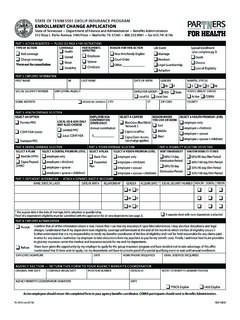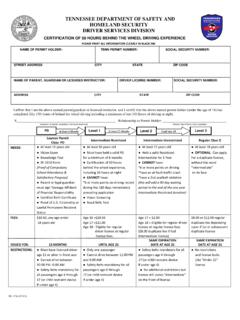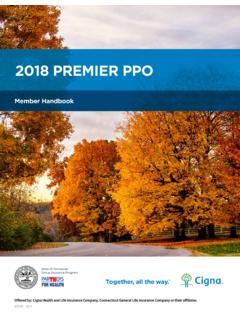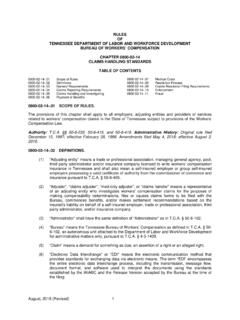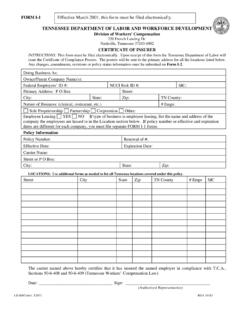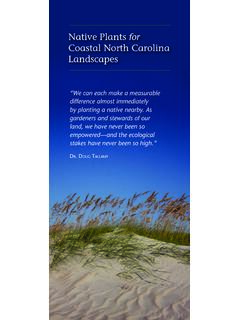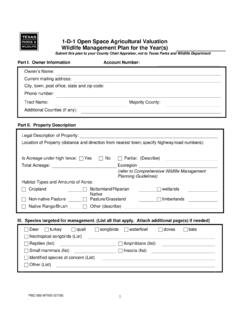Transcription of Native plant recommendations - Tennessee
1 Celebrate our natural heritage and Our natural heritage natives vs. exotics protect Native plant communities EAST Tennessee The use of Native plants in landscaping is a celebration of our natural heritage and an awakening of a land ethic first While many exotics are harmless, others pose serious threats to biodiversity. Exotics that escape and naturalize 1. Learn more about Native plants . Unaka Mountains, Ridge and Valley, expressed by Aldo Leopold more than 50 years ago. change the floral composition of Native plant communi- ties. Exotics that invade Native plant communities spread, 2. Buy nursery propagated plant material. Cumberland Plateau and Mountains The natural processes from which natives evolve repre- sent the cog and wheel of a healthy ecosystem sustained out-compete, and displace natives .
2 Other exotics are 3. Don't dig plants from the wild. by a complex web of biological diversity. vectors for disease and exotic insects. Future introduc- tions can be prevented by using Native species. 4. Protect Native plant and natural area habitat . Native plants have many inherent qualities and adaptive Using natives also exhibits regional flora and promotes traits that make them aesthetically pleasing, practical, 5. Promote responsible landscaping practices. and ecologically valuable for landscaping. our natural heritage. natives have often been overlooked and their aesthetic value ignored. Instead, many regions 6. plant Native and not exotic plant species. Using Native plants contributes to the health and often look the same because overuse of the same exotics has the restoration of an ecosystem.
3 Landscaping with created a monotonous, predictable landscape. For more information natives in an urban setting helps restore regional charac- Great Smoky Mountains National Park ter and places fewer demands on resources. Basics about using natives 107 Park Headquarters Road When landscaping with natives match the right plants Gatingburg TN 37738. 423/436-1706 with the right site conditions. Consider using plants that occur together in their natural habitats. Do your home- Tennessee Dept. of Environment and Conservation work before planting; study the plants and the site con- (TDEC). Division of Natural Heritage dition information in this brochure. Visit a natural area 401 Church St., 8th floor, L & C Tower and observe how plants occur and design your landscape Nashville TN 37243-0447 accordingly.
4 Buy nursery propagated plants . Remember, 615/532-0436 landscaping with natives is art imitating nature. Tennessee Exotic Pest plant Council (TN-EPPC). Box 40692. Nashville TN 37204. Benefits of natives 615/532-0436 Native Adapted to regional conditions and may require less maintenance and are cost-effective. Tennessee Native plant Society species naturally occurring in a region (indigenous). Department of Botany Hardy, withstand extreme winter cold, do not suffer University of Tennessee Exotic from die back. Knoxville TN 37996-1100 species introduced by humans, either deliberately 423/974-2256 Environmentally friendly, require fewer pesticides and or accidentally (alien, non- Native ). fertilizers because of natural adaptations. Promote biodiversity and stewardship.
5 Provide food and shelter for Native wildlife. What are natives ? Restore regional landscapes. Text by natives are plants that evolved in place over geologic time Warner Park Nature Center Prevent future exotic introductions. and are distributed across the landscape largely in Tennessee Natural Areas Program response to climatic episodes and adaptation to site in the Division of Natural Heritage/TDEC. conditions related to land formation. natives for wildlife Great Smoky Mountains National Park Brochure made possible by LANDSCAPING natives are generally defined as plants that occurred in Using natives in landscaping helps sustain Native butter- flies, moths and other beneficial insects; Native birds, TN-EPPC. Co-sponsored by WITH North America before European settlement.
6 This distinc- tion is made because of the large-scale changes in the reptiles, mammals, and other fauna. Fall migrating birds depend on high-energy fruits from flowering dogwood Invasive plant Control Inc. (Nashville). Native Gardens (Greenback). North Chickagmauga Creek Conservancy (Chattanooga). Native flora that have resulted since European settlement and the introduction of exotic plants . and spicebush. Spring migrants feed on insects that occur on oak trees. Reflecting Riding Arboretum & Botanical Gardens (Chattanooga). plants Exotics are plants that are directly or indirectly, deliber- ately or accidentally introduced by human action. To be Beech and other Native trees provide nesting habitat , while Eastern red cedar, Personalized Plantings (Pigeon Forge).
7 More precise, natives are natural elements of a regional short leaf pine, and American holly Tennessee Native plant Society Tennessee Field Office of The Nature Conservancy PROMOTES BIODIVERSITY landscape. While some species are Native to North provide winter cover and food. TDEC Division of Natural Heritage America, they may be exotic to East Tennessee . TDEC Bureau of State Parks and endorses a land ethic that Tennessee River Gorge Trust (Chattanooga) Don't dig plants from the wild. Tennessee Wildlife Resource Agency celebrates our natural heritage Tennessee Valley Authority Buy nursery-propagated plant material. 100% post-consumer recycled paper 598. Native plant recommendations FERNS. EAST Tennessee Maidenhair fern Ebony spleenwort Adiantum pedatum Asplenium platyneuron Lady fern Athyrium felix femina ssp.
8 Asplenioides Unaka Mountains, Ridge and Valley, Common grape fern Bulblet fern Botrychium dissectum Cystopteris bulbifera Cumberland Plateau and Mountains K LIGHT SOIL MOISTURE SOIL pH. Hay scented fern Shining club moss Dennstaedtia punctiloba Lycopodium lucidulum Sensitive fern Onoclea sensibilis The Unaka Mountains, the Ridge and Valley, and the F = full sunlight H = hydric; wet, plants periodically or often inundated by water B = basic; prefers limestone Cumberland Plateau and Mountains are distinctively E P = partial shade S = shade M = mesic; moist, adequate soil moisture retention year-round S = sub-xeric; moist to dry, seasonally moist, periodically dry A = acidic; prefers acidic soils R = restricted to either B or A. Cinnamon fern Christmas fern Osmunda cinnamomea Polystichum acrostichoides different physiographic regions that make up East Tennes- see.
9 Site conditions for each province are determined by Y X = xeric; dry & drought resistant, little moisture retention, excessively drained Common woodsia Chain fern Woodsia obtusa Woodwardia areolata GRASSES AND SEDGES. topography, soil pH, soil depth, elevation, availability of COMMON NAME SCIENTIFIC NAME LIGHT MOISTURE SOIL pH COMMON NAME SCIENTIFIC NAME LIGHT MOISTURE SOIL pH. Big bluestem Andropogon gerardii Split beard bluestem Andropogon ternarius light, and hydrology. These varying site conditions F P S H M S X B A R F P S H M S X B A R Broomsedge Andropogon virginicus support a mosaic of Native plant communities. SHRUBS SMALL TREES (continued) River cane Arundinaria gigantea ssp. gigantea Alder Alnus serrulata Staghorn sumac Rhus typhina Plaintain leaved sedge Carex plantaginea Dry, higher-elevation, south-facing slopes have Serviceberry Amelanchier laevis Mountain ash Sorbus americana River oats, spangle grass Chasmanthium latifolium Oat grass Danthonia compressa extremely acidic soils that support evergreens such as Indigo bush Amorpha fruticosa Southern rusty blackhaw Viburnum rufidulum Canada wild rye Elymus canadensis mountain laurel and pines, as well as oaks, huckleberry, Red chokeberry Aronia arbutifolia Northern blackhaw Viburnum prunifolium Sugarcane plumegrass Erianthus giganteus Black chokeberry Aronia melanocarpa Narrow plumegrass Erianthus strictus blueberries, and hickories.
10 Bottle brush Hystrix patula Sweetshrub Calycanthus floridus TREES. Switch grass Panicum virgatum On north-facing slopes, a mixed mesophytic forest American beautyberry Callicarpa americana Red maple Acer rubrum Indian grass Sorghastrum nutans New Jersey tea Ceanothus americanus Silver maple Acer saccharinum . community occurs that includes hemlock, tulip poplar Buttonbush Cephalanthus occidentalis Sugar maple Acer saccharum GROUND COVERS MOSAIC FOR FULL SUN. and maple. Cumberland rosemary Conradina verticillata Yellow buckeye Aesculus flava Hog peanut Amphicarpaea bracteata Big blue stem Andropogon gerardii Pussy's toes Antennaria plantaginifolia Butterfly weed Asclepias tuberosa Hazelnut Corylus americana Black birch Betula lenta . Hydric plants occur in drainages, floodplains and Wild ginger Asarum canadense River oats Chasmanthium latifolium Leatherwood Dirca palustris River birch Betula nigra Mouse eared coreopsis Coreopsis auriculata Joe-Pye weed Eupatorium dubium upland swamps; these include sweetgum, sycamore, Hearts-a-bustin Euonymus americanus Bitternut hickory Carya cordiformis Rattlesnake plaintain Goodyera pubescens Carolina jasmine Gelsemium sempervirens ironwood, and birches.
